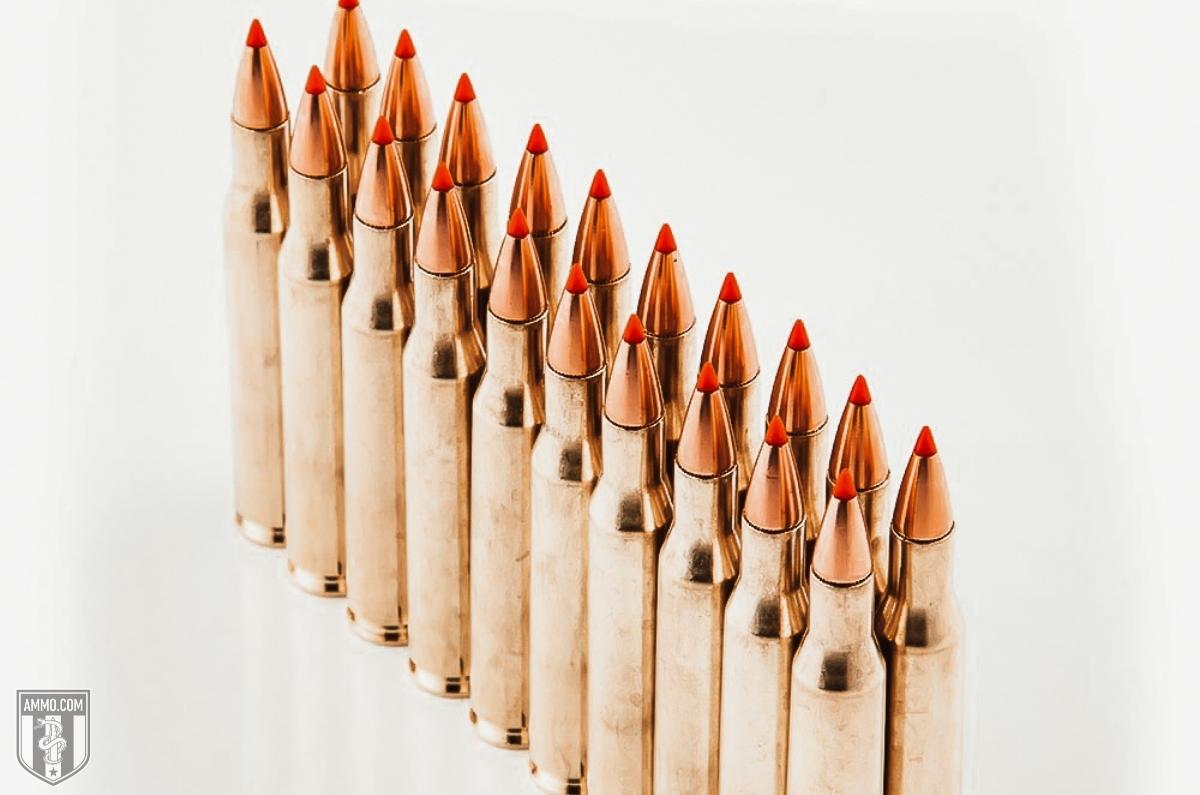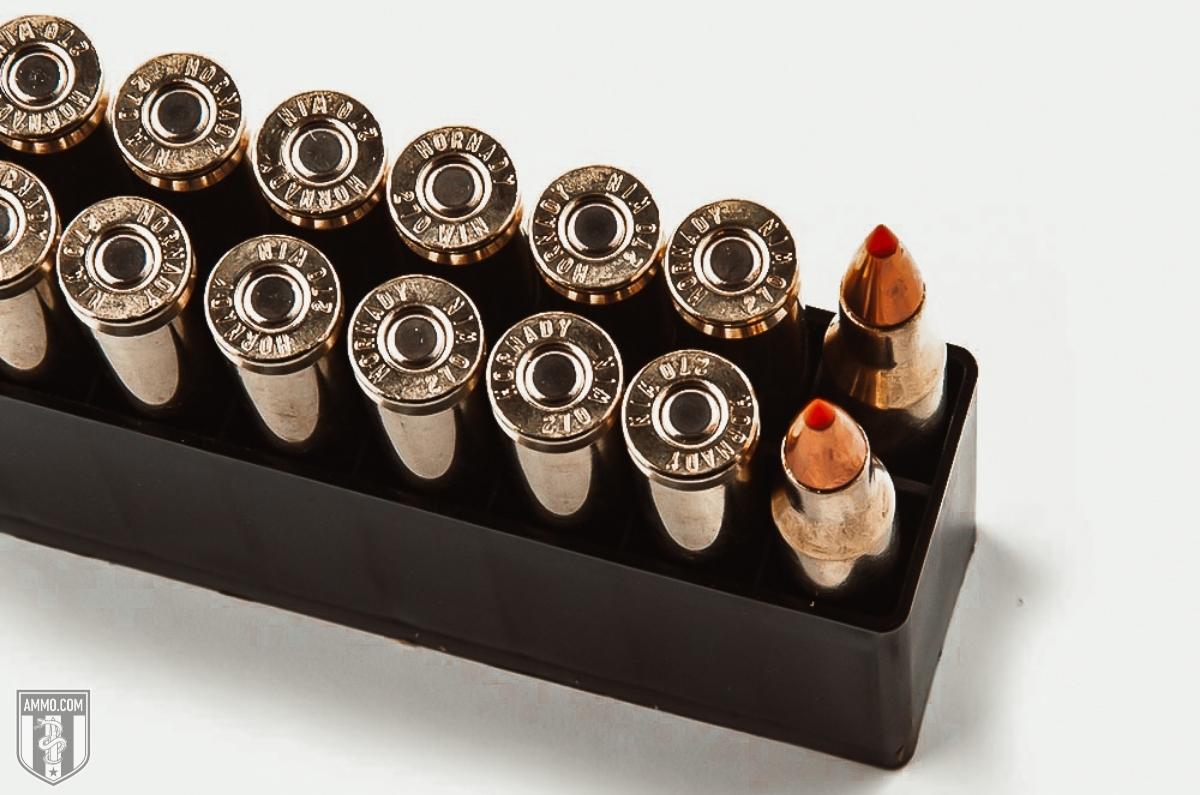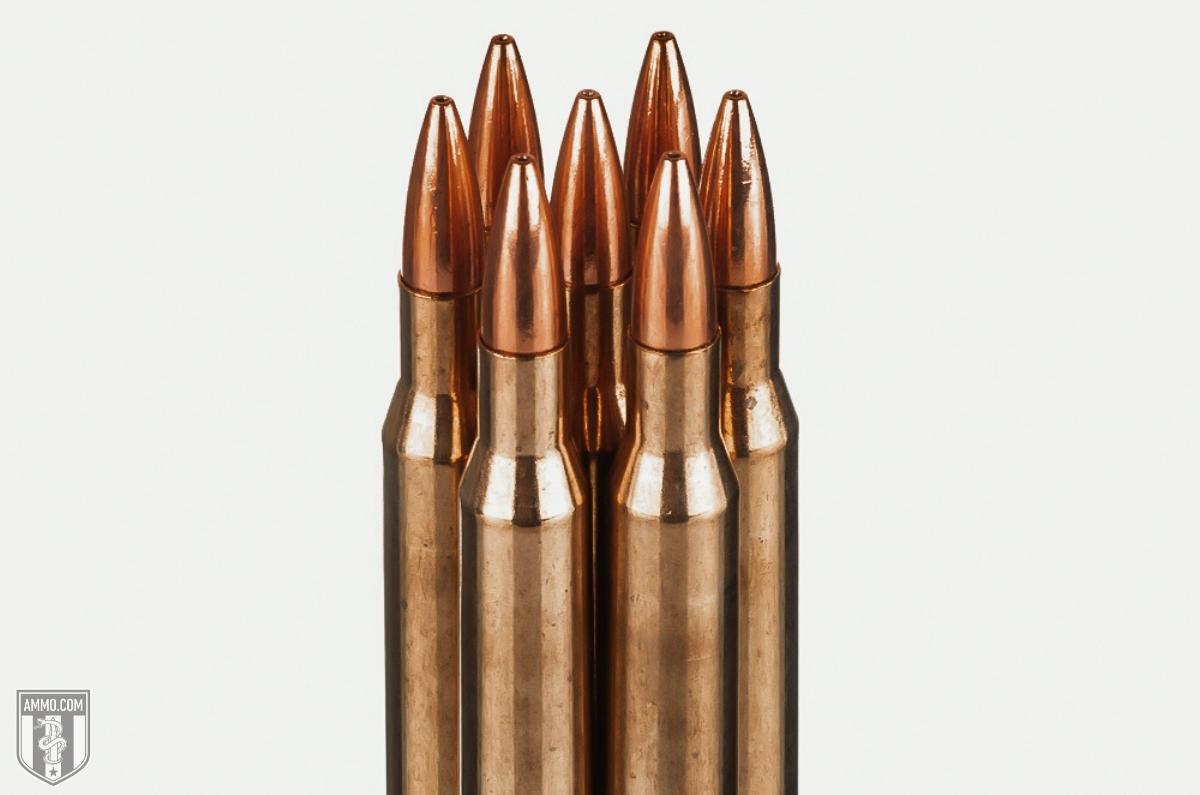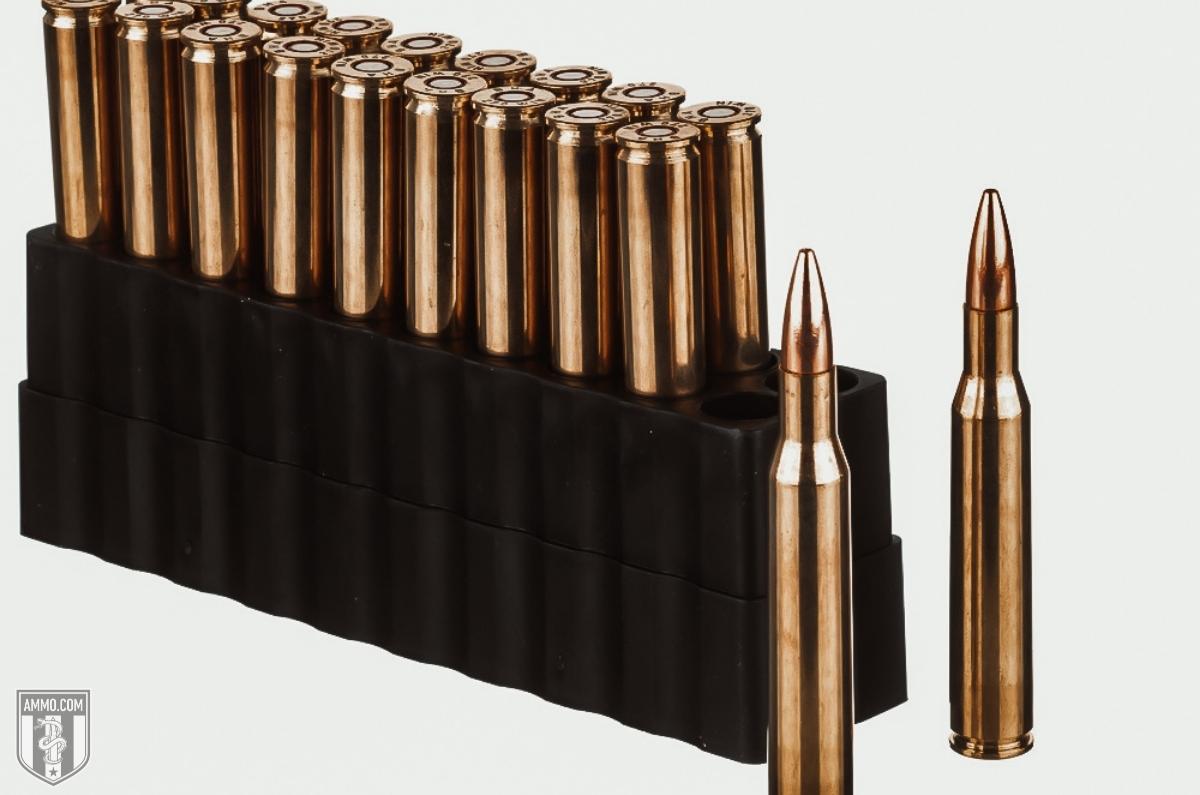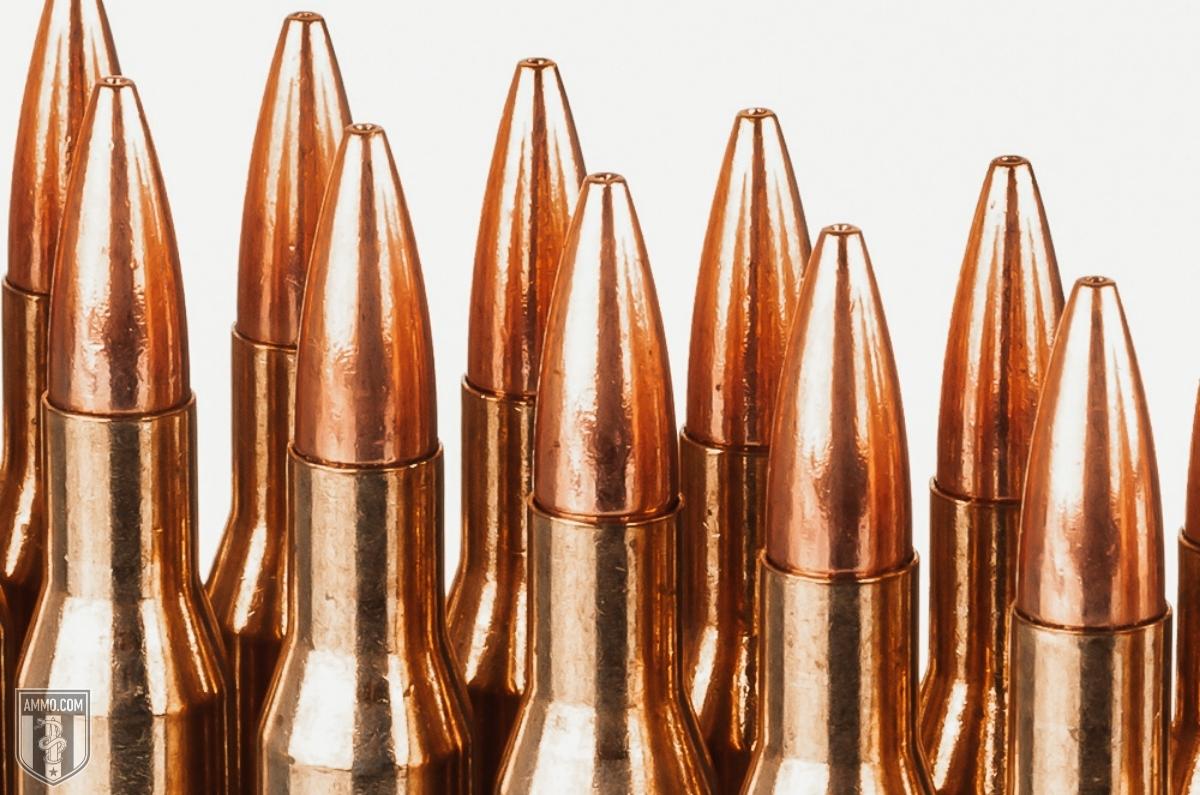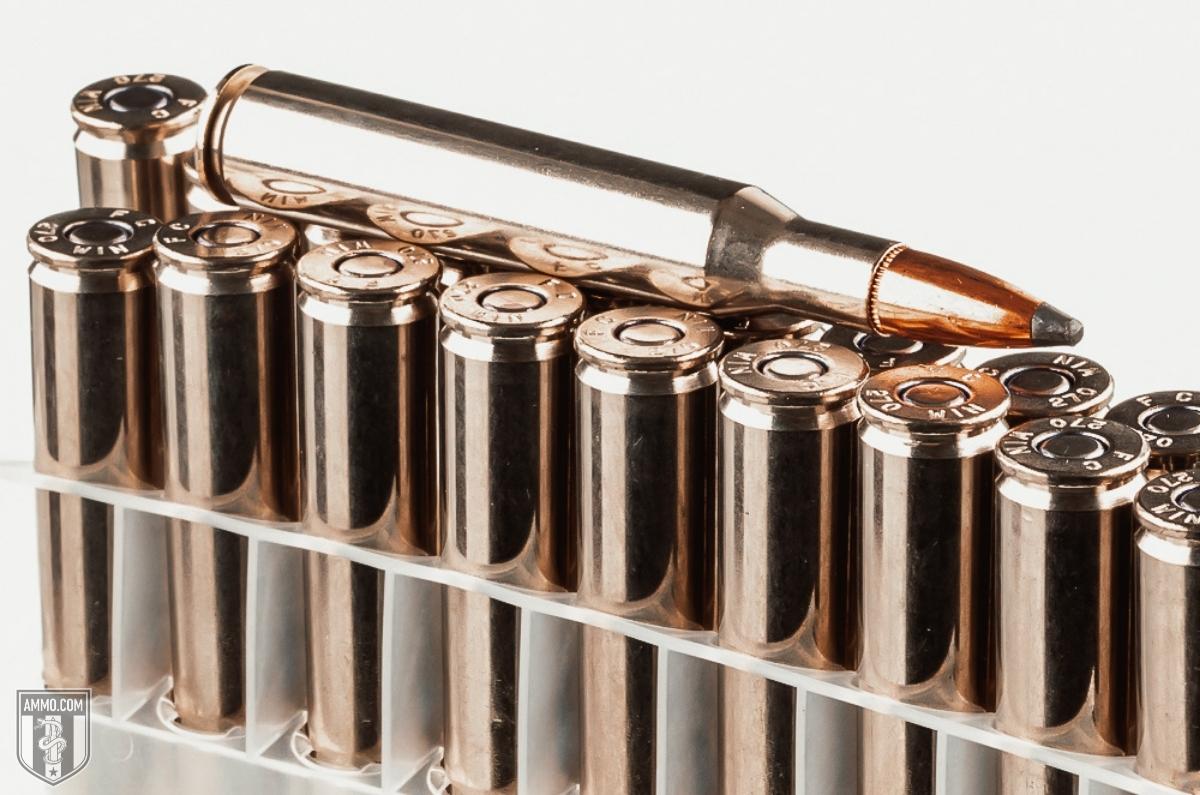7mm08 vs 270: The 7mm Whitetail Slayers
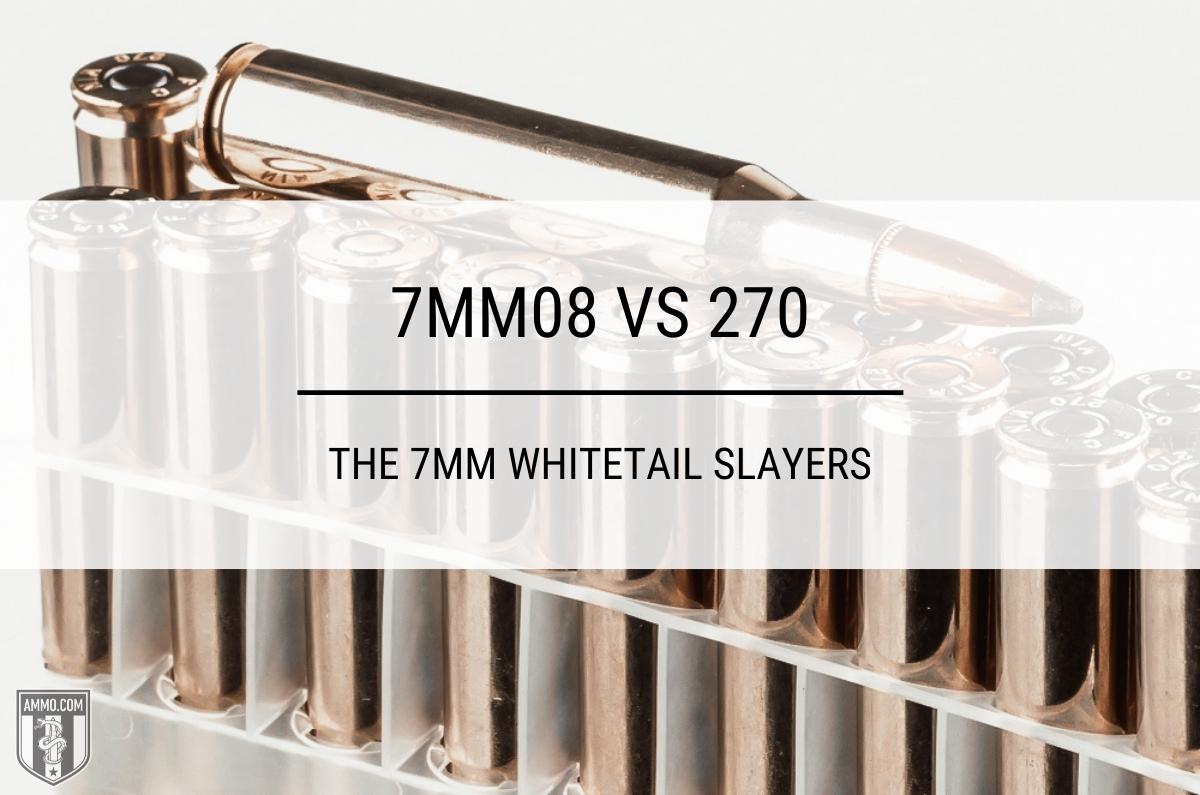
For over a century, the North American hunting scene has been dominated by 30 caliber cartridges like the 30-06 Springfield, 300 Win Mag, 308 Winchester, and 300 WSM. Although the effectiveness of .308” diameter bullets has been well documented, many hunters are transitioning to smaller diameter bullets with less recoil and higher muzzle velocities.
This transition has become more mainstream with the success of the 6.5 Creedmoor, however two extremely potent big game hunting rounds that pre-date the 6.5mm craze are the 270 Winchester and 7mm-08 Remington.
The 7mm-08 Remington and 270 Winchester are two rifle cartridges that have more similarities than differences.
Although the 270 Win has a slightly larger case with an increased case capacity and marginally improved downrange performance, the 7mm-08 offers shooters comparable ballistic performance with less recoil in a short action rifle.
In this article, we will evaluate the 270 vs 7mm-08 Rem to help you understand the differences between the two and give you a clearer idea of which cartridge is best for your shooting needs.
What is the difference between 7mm08 and 270?
The main difference between 7mm08 and 270 Win is that the 270 has higher case capacity than 7mm08. This in turn, means that 270 factory loads will have slightly higher muzzle velocities than the 7mm-08 for comparable bullet weights.
Cartridge Specs
When evaluating centerfire rifle cartridges, it’s a good idea to analyze the cartridge specs to gain more knowledge of each.
The 270 Winchester (or 270 Win for short) is the eldest of the two cartridges, being released in 1923. The 270 was developed using the 30-03 as a parent case. The 30-03 was the progenitor to the lauded 30-06 Springfield, which means the 270 Win is essentially a 30-06 case necked down to accept a 0.277” (7mm) diameter bullet.
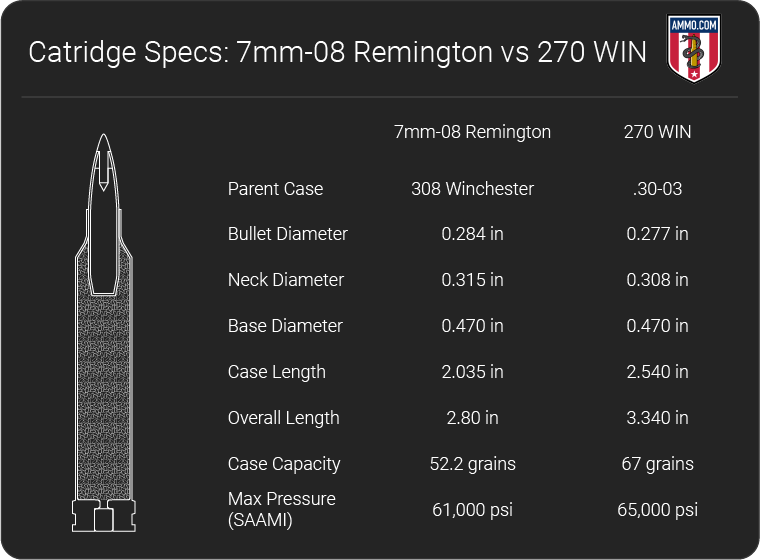
The 7mm-08 Remington (7mm08 or 7mm-08 Rem for short), on the other hand, is a youngster compared to the 270, as the 7mm08 was released in 1980. The 7mm08 was developed using the 308 Winchester as a parent case, which is interesting as the 308 was developed to replace the 30-06 (the parent case for the 270). Similar to the 270, the 7mm-08 uses a 308 case necked down to accept a 0.284” (7.2mm) diameter bullet and was developed to mimic the ballistic performance of the 7x57 Mauser.
Saying the 7mm-08 fires a 7mm bullet is a bit of a misnomer, as the 270 fires a true 7mm bullet diameter while the ’08 fires a 7.2mm bullet. While most shooters won’t make much of a fuss over the difference between 7mm vs 7.2mm diameter bullets (and I doubt a mule deer can tell the difference), handloaders need to be aware of the difference when reloading for each cartridge.
One striking difference between the 7mm-08 vs the 270 is the difference in case length, as the 270 stands a full half inch taller at 2.54” than the 7mm08 at 2.035”. The same holds true for overall length as well, with the 270 measuring in at 3.34” compared to 2.80” for the 7mm-08.
Primarily built as hunting rounds, the 270 Win and 7mm-08 are predominantly fired from bolt-action rifles, however the difference in overall length directly corresponds to which action each cartridge fits into. The 270, like its parent the 30-06, fits into a standard or long action while the 7mm-08 Rem holds true to its 308 roots and fits into short action.
A short action will require slightly less bolt throw to cycle a round and is typically a little lighter than a standard or long action. This means that follow up shots can be slightly faster in a short action compared to a long action.
The longer case of the 270 allows it to house more gunpowder than the 7mm-08, with the 270 maintaining a 67gr case capacity compared to 52.2 gr for the 7mm08. This capacity difference also correlates with the SAAMI maximum chamber pressures for each hunting cartridge, with the 270 Win being capable of handling 4,000 psi more at 65,000 psi compared to 61,000 psi for the 7mm-08.
Recoil
Although both hunting cartridges are close in terms of recoil, the 7mm-08 Remington has slightly less recoil than the 270 Win.
Recoil is an important consideration when purchasing a new rifle as a round with heavy recoil will be more difficult to control and will slow your rate of follow up shots.
Recoil is affected primarily by muzzle velocity (FPS), powder charge, bullet weight, and rifle weight.
Even though both rifle cartridges generally fire similar bullet weights, the lower powder charge for the 7mm-08 lends itself to lower recoil.
For this example, we will compare two 150-grain bullets that are popular for both chamberings. For the 270 Winchester we will analyze the 150 gr Nosler Accubond and compare it to the Hornady 150 gr ELD-X for the 7mm-08 Rem.
Assuming an identical 7-pound rifle is used for each round, the 7mm08 will have a free recoil energy of 18.88 ft-lbs compared to 22.36 ft-lbs for the 270 Win.
It is true that the 270 Win has slightly more free recoil than the 7mm-08, but most shooters will not be able to tell much of a difference between the two rounds.
Muzzle Velocity, Kinetic Energy, and Trajectory
With its higher case capacity, the 270 Winchester typically has a slight edge over the 7mm-08 in terms of muzzle velocity, kinetic energy, and have a flatter trajectory when comparing bullets of similar weight.
For the purpose of this comparison, we selected 4 different factory loads to analyze. For the 270 Winchester, the 130 gr Hornady SST and 150 gr Nosler Accubond and for the 7mm-08 Rem the 120 gr Barnes TTSX and Hornady 150 gr ELD-X.
As you can see, the 270 Win surpasses the 7mm-08 in terms of ballistic performance at all ranges when comparing similar bullet weights. For example, the 130 gr SST has a muzzle velocity of 3,200 fps for the 270 compared to 3,005 fps for the 120 gr TTSX for the 7mm.
Muzzle energy tells a similar tale, as the 7mm simply cannot keep up with the 270. For the 150-grain bullets, the 270 Winchester’s Accubond leaves the muzzle with 2,705 ft-lbs of energy compared to 2,555 ft-lbs for the ELD-X of the 7mm-08.
In terms of trajectory, both hunting cartridges are very flat shooting and comparable out to 300 yards with a 4” difference in bullet drop between all four loads. However, at longer ranges the 270 Win has a flatter trajectory and can maintain its velocity and energy more efficiently.
Although it seems like the 270 is simply better than the 7mm-08, it is important to note that both rounds have similar ballistic performance within normal hunting ranges under 500 yards.
For example, at 400 yards the 270 Win 150 gr Accubond only has around 100 fps more velocity, 150 ft-lbs more kinetic energy, and about 2” less bullet drop compared to the 150 gr ELD-X for the 7mm08. That’s rather impressive considering the 7mm-08 fits into a short action and has slightly less recoil than the 270.
There’s no denying that the 270 Win has superior long range ballistics, however at typical hunting ranges under 500 yards, the 7mm-08 and the 270 are roughly comparable.
Ballistic Coefficient and Sectional Density
The 270 Winchester will typically have a slightly higher ballistic coefficient and sectional density compared to the 7mm-08.
Ballistic coefficient (BC) is a measure of how aerodynamic a bullet is and how well it will resist wind deflection. Sectional density (SD) is a way to evaluate the penetration ability of a bullet based on its external dimensions, design, and weight.
Although the 270 will generally have a higher BC, often the differences between it and the 7mm08 are incredibly minor.
Take for example the 140 gr Berger VLD Hunting bullets for both rifle calibers. The 270 will have a BC of 0.504 while the 7mm has a BC of 0.500. Another example is the 140 gr SST for 270 and 139 gr GMX for 7mm-08 with a BC of 0.495 and 0.486, respectively.
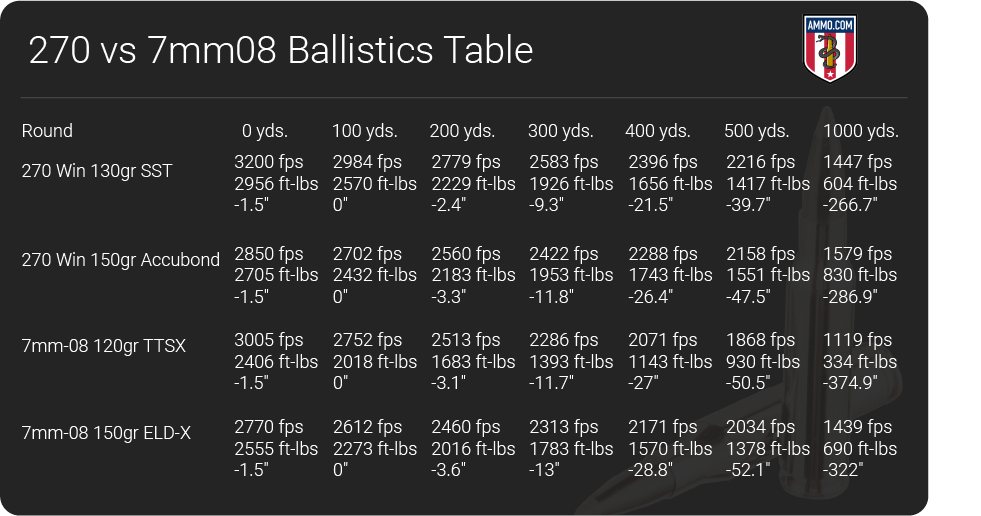
For sectional density, the 270 Win has a slight edge over the 7mm08. This is due to the 270 firing a slightly slenderer bullet at higher velocities, meaning that all the force of the bullet can be localized on a smaller area and therefore penetrate deeper into the target.
Take for example the 150 gr GameKing bullets by Sierra for both calibers. The 270 will have a SD of 0.279 while the 7mm-08 will have a SD of 0.266.
In general, the 270 will have a higher BC and SD than the 7mm-08, however the differences between the two are razor thin when comparing bullets of similar design.
Hunting
Both the 270 Winchester and 7mm-08 Remington make an excellent choice for your next hunting rifle.
The late Jack O’Connor of Outdoor Life magazine spent a good part of his career expounding on the versatility of the 270 as a hunting cartridge. Sadly, he passed away before the release of the 7mm-08, as it would have been interesting to hear his take on the 7mm since it can do almost everything that his belove 270 can do while chambered in a short action rifle.
One of the major advantages of both cartridges is having factory ammo available in a wide range of bullet weights. Factory loads for 270 and 7mm-08 are loaded with projectiles as low as 96 grains and as high as 160 grains, giving hunters the option to take on mid-sized varmints like coyotes all the way up to big game like elk and black bear.
However, what both cartridges are most well-known for is their effectiveness against whitetail and mule deer. Both rounds carry enough kinetic energy to ethically harvest deer at ranges over 500 yards and have less free recoil than traditional big game hunting cartridges like the 300 Win Mag or 308 Winchester.
In terms of African game, both rounds would be effective for Springbok, Impala, and Kudu. For larger and dangerous game like Cape Buffalo or elephant, the 270 and 7mm-08 lack the kinetic energy needed to harvest these animals and you’d want something bigger like a 416 Ruger or 460 Weatherby Magnum.
Ammo and Rifle Cost/Availability
As the 270 Winchester is an older caliber, there will generally be more availability in terms of ammo and firearms than the 7mm-08.
In terms of ammo availability, the 270 Win typically enjoys a 2:1 margin in terms of factory ammo varieties. The popularity of the 270 is mostly due to Jack O’Connor pumping it for years in Outdoor Life magazine as well as being on the market for almost 60 years longer than the 7mm-08.
In terms of price, there is not a lot of difference between the 270 and 7mm-08 Remington.
Inexpensive 270 ammo typically runs around $1.50-$2/round with premium hunting ammo starting around $3/round at the time of writing. For 7mm-08 Rem, low end hunting ammo starts around $2/round with premium grade ammo going for about $3-$4/round.
Since we're on the subject of ammo cost, don't forget to check out on our Remington .270 Ammunition page for more options.
Although the 270 is slightly less expensive, most hunters will not shoot through thousands of rounds per year. Instead, they will typically use a few boxes to zero their hunting rifle before the season opens and then maybe go through a box or two in the field. Therefore, ammo cost is less of an issue when selecting either cartridge for your next hunting rifle.
Both the 270 and 7mm-08 are considered hunting cartridges almost exclusively, therefore most firearms available for both calibers will be bolt-action rifles.
In terms of rifle availability, there will be more 270 rifles on the used market due to its age, but in general both calibers have similar rifle availability in new rifles.
Even though the 7mm-08 is a relatively newcomer to the hunting scene, rifle manufactures have seen the utility of the cartridge and have several offerings for every budget. For entry level rifles, the Ruger American and Savage Axis are both chambered in each cartridge, while the Winchester Model 70, Remington 700, and Weatherby Vanguard are popular options for higher end bolt-action rifles.
The primary semi-auto option is the Browning BAR, as it is available in both 270 Win and 7mm-08 Remington.
Reloading
If you like to handload your own ammo, both cartridges offer you a lot of options for customization in terms of projectiles and powders to make the perfect sub-MOA reloads for your hunting rifle.
Projectiles for the 270 will typically be easier to come by as the caliber has seen a lot of hype surrounding the adoption of the 277 Sig Fury round by the US military. Furthermore, 0.277” diameter bullets are also used in the 6.8 SPC, 270 Weatherby Magnum, 270 WSM, and 27 Nosler.
For the 7mm-08, there is still a lot of bullet availability as the 7mm Rem Mag, 7x57 Mauser, and 280 Remington are also popular cartridges that fire a 0.284” diameter bullet.
It’s important for reloaders to remember the differences between bullets and how manufacturers name them before placing an order. Often bullets for the 270 Win will be labeled as 0.277” or 270 while bullets for the 7mm-08 can be referred to as 7mm or 0.284”. The “7mm” designation for 0.284 can be confusing to some new handloaders as they are technically 7.2mm in diameter. Always ensure that you purchase the correct projectiles for your caliber of choice.
As far as powders are concerned, there is a wide variety of options from manufactures like IMR, Hodgdon, and Accurate, and Ramshot for both 270 Win and 7mm-08 handloads.
Final Shots: 270 vs 7mm08
The 270 Winchester and 7mm-08 Remington are two superb hunting cartridges that are more like each other than they are different.
The 270 Winchester is the larger cartridge of the two and has superior ballistic performance thanks to its higher case capacity. However, the 270 Win also requires a long action and has slightly more recoil than the 7mm-08.
The 7mm-08 Remington is a newer addition to hunters’ arsenals, but it offers some qualities that the 270 cannot. As the 7mm-08 was based off the 308 Winchester, the 7mm-08 can fit into a short action and has slightly less recoil than the 270 with comparable ballistic performance at traditional hunting ranges.
Although the 7mm-08 offers several advantages, ammo availability is a consideration as there is nearly 2x more ammo options for 270 than 7mm-08 Rem. Many hunters will prefer the tried-and-true 270 Winchester as it is easier to find rifles, ammo, and projectiles for reloading.
However, if you’re in the market for a new hunting rifle and you want something a little more compact, then the 7mm-08 Remington might be a good choice to fill your shooting needs.
No matter which cartridge you choose, make sure you stock up on ammunition here at Ammo.com and I’ll see you on the range!
Ammo Comparisons
- .308 vs 5.56
- 6.5 Creedmoor vs .308
- .300 Blackout vs .308
- .300 Win Mag vs .308
- .243 vs .308
- .308 vs .30-06
- 7mm-08 vs .308
- .270 vs .308
- 7.62x39 vs .308
- .223 vs .308
- .338 Lapua vs .308
- .380 ACP vs 9mm
- .223 vs 5.56
- .300 Blackout vs 5.56
- 9mm vs 45 ACP
- 9mm vs 40 S&W
- .357 SIG vs 9mm
- 10mm vs 9mm
- 9mm vs 9mm Luger
- .243 vs .270
- .300 Win Mag vs .30-06
- .270 vs .30-06
- .40 vs .45
- 38 Special vs 357
- 9mm vs 40 vs 45
- 5.56 vs 7.62x39
- 338 Lapua vs .30-06
- .30-30 vs .30-06
- 300 PRC vs 338 Lapua
- .30-06 vs 7mm
- 300 Win Mag vs 338 Lapua
- 300 PRC vs 300 Win Mag
- 300 WSM vs 300 Win Mag
- 338 Win Mag vs 338 Lapua
- 12 Gauge vs 20 Gauge
- 10mm vs 357 Mag
- .30-30 vs 7.62x39
- 224 Valkyrie vs 22-250
- 17 HMR vs 22 Mag
- 7.62x39 vs .300 Blackout
- 45 ACP vs 45 Auto
- 45-70 vs 30-30
- 300 Blackout vs 223
- 357 Magnum vs 9mm
- 350 Legend vs 300 Blackout
- 224 Valkyrie vs 223
- 45 ACP vs 38 Super
- 6.5 Grendel vs .308
- 17 HMR vs 22 LR
- 10 Gauge vs 12 Gauge
- 22-250 vs 223
- 45 Colt vs 45 ACP
- 350 Legend vs 30-30
- 5.7x28 vs 223
- 5.7 vs 9mm
- 5.56 vs 5.7
- 22 vs 9mm
- Buckshot vs Birdshot
- 450 Bushmaster vs 308
- 450 Bushmaster vs 223
- Buckshot vs Slug
- 6.5 Grendel vs 5.56 vs 223
- 6mm ARC vs 6.5 Grendel
- 44 vs 45
- 458 SOCOM vs 5.56
- 357 vs 44
- 32 ACP vs 380
- 300 Win Mag vs 338 Win Mag vs 338 Lapua Mag
- 450 Bushmaster vs 458 SOCOM vs 50 Beowulf
- 6mm Creedmoor vs 6.5 Creedmoor
- TMJ vs FMJ
- 44 Special Vs 44 Magnum
- 45 90 vs 45 70
- 6.8 Western vs 6.8 SPC
- 50 Beowulf vs 50 BMG
- 26 Nosler vs 6.5 PRC
- 28 Gauge vs 410
- 6.8 SPC vs 5.56
- 6.8 SPC vs 6.5 Grendel
- 6.8 Western vs 7mm Rem Mag vs .28 Nosler
- 6.8 Western vs 6.5 Creedmoor
- 22 Hornet vs 223
- 6.8 Western vs 6.5 PRC
- .410 vs 12 Gauge
- .410 vs 20 Gauge
- 22 LR vs 22 Mag
- 6mm ARC vs 243
- 7mm-08 vs 270
- 243 vs 6.5 Creedmoor
- Nickel vs Brass Casing
- 204 Ruger vs 223
- 50 Beowulf vs 5.56
- 260 Remington vs 6.5 Creedmoor
- 6mm Remington vs 243
- 28 Nosler vs 300 PRC
- 50 Beowulf vs 50 AE
- 22 Nosler vs 22-250
- 450 Marlin vs 45-70
- 300 Win Mag vs 300 Norma
- 458 SOCOM vs 300 Blackout
- 38-55 vs 45-70
- 22 Hornet vs 22 LR
- 300 Norma vs 338 Lapua
- 338 Lapua vs 50 BMG
- 28 Nosler vs 300 Win Mag
- 28 Nosler vs 6.5 Creedmoor
- 204 vs 22-250
- 458 SOCOM vs 45 70
- 44 40 vs 45 70
- 6.8 SPC vs 6.5 Creedmoor
- 450 Bushmaster vs 30-06
- 7mm Rem Mag vs 300 Win Mag
- 30 Carbine vs 223
- 25-06 vs 30-06
- 26 Nosler vs 28 Nosler
- 16ga vs 12ga
- 30 06 vs 7.62 x54R
- 9mm Makarov vs 9mm Luger
- 350 Legend vs 223
- 30 Carbine vs 5.56
- 6.5x55 vs 6.5 Creedmoor
- 6.5 Creedmoor vs 270 vs 25-06
- M193 vs M855
- 450 Bushmaster vs 458 SOCOM
- 6.5 Grendel vs 6.5 Creedmoor
- 350 Legend vs 5.56
- .277 Fury vs 6.8 SPC
- 277 Fury vs 300 Win Mag
- 10mm vs .45 ACP
- 277 Fury vs 223
- 6.8 SPC vs 300 Blackout
- 6.5 PRC vs 6.5 Creedmoor
- 277 Fury vs 308
- 277 Fury vs 6.5 Creedmoor
- 350 Legend vs 450 Bushmaster
- 277 Fury Vs 5.56 NATO
- 10mm vs 40S&W
- 32 ACP vs 9mm
- 32 Special vs 9mm
- 8.6 Blackout vs 300 Blackout
- 30 Super Carry vs. 9mm
- 5.56 vs 9mm
- .50 Action Express vs 9mm
- 7.62x25 vs. 9mm
- 10mm vs 44 Magnum
- 300 Blackout vs 300 Win Mag
- 6.5 Grendel vs 300 Blackout
- 460 Rowland vs 10mm
- 300 RUM vs 300 PRC
- 300 Norma vs 300 PRC
- 45 GAP vs 45 ACP
- 7mm PRC vs 300 Win Mag
- 300 PRC vs 6.5 Creedmoor
- 300 PRC vs 308
- 357 SIG vs 357 Mag
- 7.62x39 vs 7.62x51
- 243 Win vs 223 Rem
- 30 Nosler vs 300 PRC
- 6.5 Creedmoor vs. 30-06 Springfield
- 450 S&W vs. 44 Magnum
- 6.5 Creedmoor vs. 300 Win Mag
- 454 Cassull vs. 45-70 Govt
- 454 Cassull vs. 44 Mag
- 7.62x54r vs. 308 Winchester
- 22 ARC vs. 223 Rem
- Subsonic vs. Supersonic Ammo
